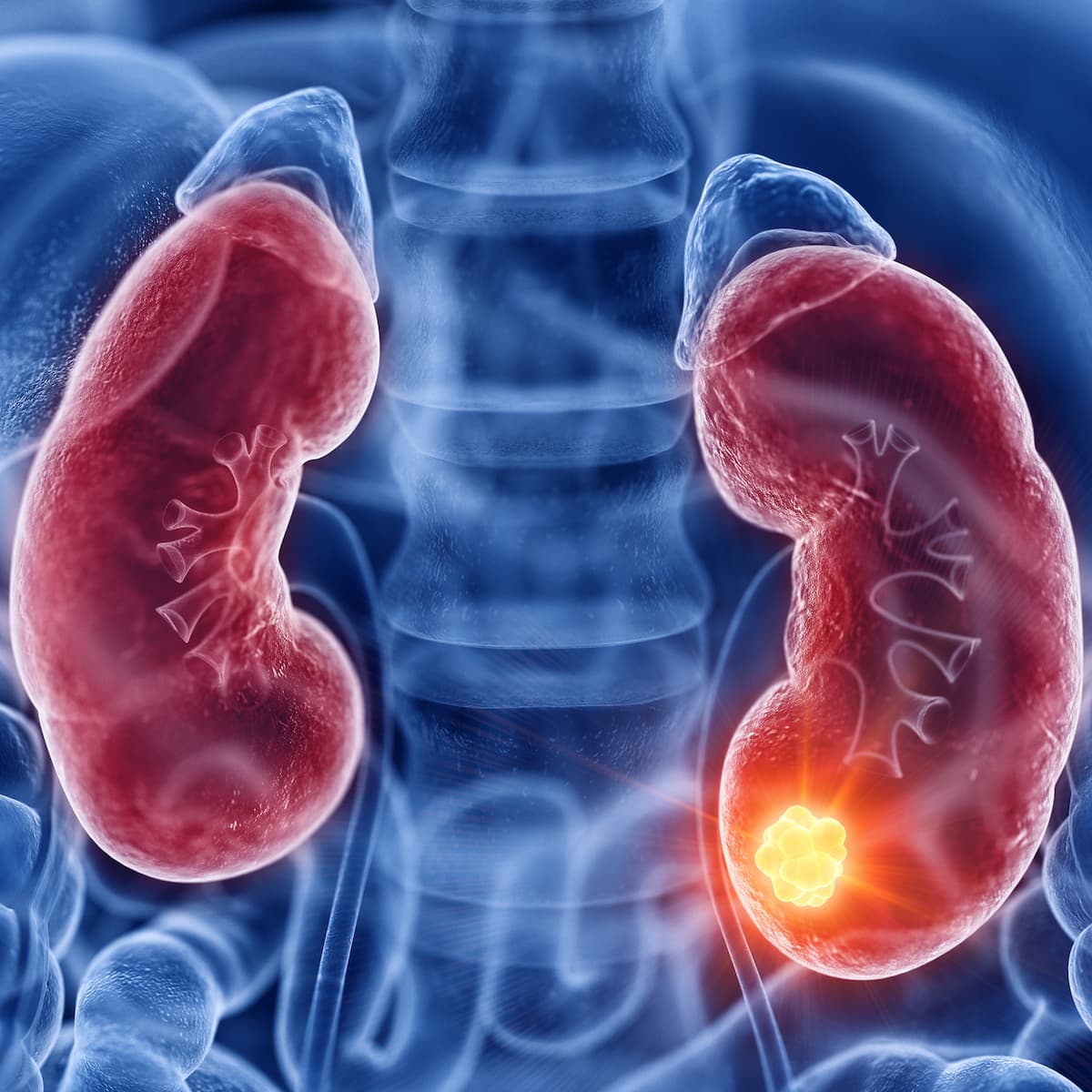Pembrolizumab Combo Yields Enduring Activity in Advanced Non-Clear Cell RCC
Data from the KEYNOTE-B61 trial demonstrate antitumor activity across histologic subtypes, including those with papillary and chromophobe disease.
“After a minimum of 3 years of follow-up, pembrolizumab plus lenvatinib continued to show durable antitumor activity and promising survival outcomes in the first-line setting for [patients with] advanced [non-clear cell] RCC,” said lead study author Laurence Albiges MD, PhD.

Combining pembrolizumab (Keytruda) with lenvatinib (Lenvima) showed sustained antitumor activity and promising survival outcomes as first-line therapy for patients with advanced non-clear cell renal cell carcinoma (RCC), according to updated findings from the phase 2 KEYNOTE-B61 trial (NCT04704219) presented at the 2025 Kidney Cancer Research Summit.1
Among all evaluable patients who received pembrolizumab/lenvatinib (n = 152), the overall response rate (ORR) was 50.6% (95% CI, 42.6%-58.7%), a disease control rate (DCR) of 82.3% (95% CI, 75.4%-87.9%), and a clinical benefit rate (CBR) of 71.5% (95% CI, 63.8%-78.4%). Data showed complete responses (CRs) in 10.1% of patients and partial responses (PRs) in 40.5%.
The study treatment yielded an ORR of 53.8% in patients with papillary disease (n = 93), 31.0% in those with chromophobe histology (n = 29), and 66.7% in those with translocations (n = 6). Additionally, 50.0% and 77.8% of patients with unclassified (n = 20) and other histology (n = 9), respectively, experienced a response.
Any reduction in tumor burden occurred in 88.6% of all patients. Moreover, tumor burden reductions were observed in 91.4% of those with papillary disease, 75.9% of those with chromophobe histology, 95.0% of those with unclassified disease, 100.0% of those with translocations, and 88.9% of those with other histologies. The median duration of response (DOR) was 23.5 months (range, 1.5+ to 40.2+).
The median progression-free survival (PFS) was 17.9 months (95% CI, 15.0-21.1) across the overall population, which included a PFS rate of 39% at 24 months and 26% at 36 months. Additionally, the median PFS was 17.7 months (95% CI, 13.5-21.1) in the papillary subgroup and 11.3 months (95% CI, 6.7-29.0) in the chromophobe subgroup; in each respective group, the 24-month PFS rate was 35% and 44%, and the 36-month rate was 22% and 27%.
Across the overall population, the study treatment produced a median overall survival (OS) of 41.5 months (95% CI, 32.8-not reached [NR]), with OS rates of 67% and 54% at 24 months and 36 months, respectively. The median OS was 37.5 months (95% CI, 27.1-NR) in the papillary subgroup and NR (95% CI, 21.7-NR)in the chromophobe subgroup; the OS rates in each group were 65% vs 69% at 24 months, and the rates were 50% and 62% at 36 months.
“After a minimum of 3 years of follow-up, pembrolizumab plus lenvatinib continued to show durable antitumor activity and promising survival outcomes in the first-line setting for [patients with] advanced [non-clear cell] RCC,” lead study author Laurence Albiges MD, PhD, stated in the presentation.1 “As of now, this is one of our standards of care to treat patients, including papillary, chromophobe, or different histologies than non-clear cell [RCC]. We're excited that this has changed the paradigm for our patients.”
Albiges is head of the Department of Oncology at Institut Gustave Roussy.
In the single-arm KEYNOTE-B61 trial, 158 patients were assigned to receive pembrolizumab at 400 mg intravenously every 6 weeks for a maximum of 18 cycles plus lenvatinib at 20 mg orally once daily.
The trial’s primary end point was ORR per blinded independent central review using RECIST v1.1 criteria. Secondary end points included DOR, PFS, OS, and safety.
Patients 18 years and older with histologically confirmed stage IV non-clear cell RCC, measurable disease per RECIST v1.1 guidelines, a Karnofsky performance status of 70% or higher, and no prior therapy for advanced disease were eligible for enrollment on the trial. Having adequately controlled blood pressure with or without antihypertensive medications as well as adequate organ function were additional requirements for study entry.2
The median patient age was 60.0 years (range, 24-87). The most common histology was papillary (58.9%) followed by chromophobe (18.4%), unclassified (12.7%), other (5.7%), translocated (3.8%), and medullary (0.6%). Additionally, 12.0% of patients had sarcomatoid features, and 63.3% had an intermediate or poor International Metastatic RCC Database Consortium risk.
Investigators administered any subsequent therapy to 38.6% of the study population. The most common types of subsequent treatment included any VEGF or VEGFR inhibitor (35.4%), any mTOR inhibitor (8.9%), and any PD-(L)1 inhibitor (6.3%).
Any-grade adverse effects (AEs) affected 99.4% of patients, and 77.2% experienced grade 3 to 5 toxicities. Additionally, 31.0% of AEs resulted in treatment discontinuation, 48.1% had serious AEs, and 6.3% had AEs leading to death. Any-grade and grade 3 or higher treatment-emergent AEs (TEAEs) affected 96.2% and 60.1% of patients, respectively, and any-grade and grade 3 or higher immune-mediated AEs occurred in 58.9% and 10.1%.
The most common TEAEs included hypertension (57.6%), diarrhea (50.0%), hypothyroidism (41.1%), proteinuria (34.2%), fatigue (31.0%), palmar-plantar erythrodysesthesia syndrome (30.4%), dysphonia (29.1%), and diminished appetite (27.2%). Other TEAEs included nausea (25.3%), decreased weight (22.8%), asthenia (22.2%), arthralgia (19.6%), stomatitis (19.6%), mucosal inflammation (15.2%), and pruritus (15.2%).
References
- Albiges L, Gurney H, Lee JL, et al. Pembrolizumab plus lenvatinib for previously untreated advanced non–clear cell renal cell carcinoma: 3-year follow-up of the phase 2 KEYNOTE-B61 study. Presented at the 2025 Kidney Cancer Research Summit; July 17-18, 2025; Boston, MA. Abstract 1.
- Pembrolizumab plus lenvatinib for first-line advanced/metastatic non-clear cell renal cell carcinoma (1L nccRCC) (MK-3475-B61) (KEYNOTE-B61). ClinicalTrials.gov. Updated February 17, 2025. Accessed July 18, 2025. https://tinyurl.com/3mpcrezf
Newsletter
Stay up to date on recent advances in the multidisciplinary approach to cancer.